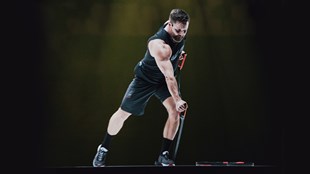One of the best ways to stay injury-free is to find out how the professionals do it.
Group fitness instructors are prolific exercisers, industry professionals who train on average for 11 to 13 hours a week – so it would be reasonable to assume their risk of injury is pretty high. However, research by Dr Jinger Gottschall of Penn State University highlights that this is not the case.
Gottschall set out to identify if there were any optimum training behaviors which helped avoid injury, surveying 3175 instructors about how often they worked out, the type of exercises they did and what injuries they had suffered, if any.
Just 13 percent of instructors reported injuries that demanded a week of rest, yet other groups with a similar training volume have reported much higher injury rates of up to 56 percent*. Gottschall puts this down to the fact that most group fitness instructors get the recommended variety of training.
The American College of Sports Medicine (ACSM) recommends the time spent in each training modality should be as follows:
- 60 percent cardio
- 30 percent strength
- 10 percent flexibility.
The instructors in the study typically divided their training as follows: 54 percent cardio, 35 percent strength and 11 percent flexibility.
“The study indicates that balance is the key to preventing injury. If people want to get fit and stay injury free, a variety of group fitness classes is vital,” says Bryce Hastings, Les Mills Head of Research.
Another way to stay injury-free is to better understand the factors that contribute to injury. We asked Steve Tansey, Les Mills Head of Research in the UK, to explain some of the common causes of injury, and how to overcome them.
PROBLEM #1: Muscle tightness
If you have tight calves you’re in good company, as tight leg muscles are extremely common. When we exercise we are constantly demanding contractions from our muscles. This continuous rate of contraction may result in a shortening of the muscle, which in turn can lead to a limited range of motion and create a muscle imbalance – which can increase our propensity for injury.
SOLUTION #1: Stretching, massage and foam rolling
Ensuring you are regularly stretching your soleus and gastrocnemius (your calf muscles) will help with correcting tightness in these muscles. A similar approach to other potential problem areas can also be of value. Stretches for the hip-flexors can also help to release the psoas (the largest hip flexor) - which in turn can help with certain types of lower back pain. If you need some stretching inspiration, check out some of the most popular stretches.
Proprioceptive neuromuscular facilitation (PNF) stretching is a popular, advanced method of deep stretching. It typically involves passively stretching a muscle (or muscle group), then performing an isometric contraction of that muscle, then once again passively stretching that same muscle to achieve a deeper stretch at a greater range of motion. Foam rolling can also assist with helping the muscle to relax. Read more on the benefits of foam rolling.
PROBLEM #2: Muscle weakness
Muscle weakness occurs when our full effort doesn’t produce a normal muscle contraction or movement. We can experience this at the end of a gruelling workout, when we have simply exhausted ourselves, however, persistent muscle weakness may indicate an underlying muscle imbalance. Stronger muscles can begin to dominate weaker ones, resulting in uneven forces acting on our joints. These imbalances can place excessive strain on joints as we have less control during impact activities or in the way we stabilize our joints when lifting.
SOLUTION #2: Manual muscle testing and strengthening (or consult your sports medicine practitioner)
If you believe this to be related to a muscle imbalance, an assessment from a qualified sports practitioner will help determine the cause of your muscle weakness the appropriate treatment. In some cases, physical therapy may be helpful.
Manual muscle testing of the affected area may also highlight an asymmetric weakness (one side is weaker than the other). Identifying this makes it possible to realign/balance the body through isolated strengthening on the weaker side.
PROBLEM #3: Overtraining and overuse
The most obvious problem of all! When we do too much, with too little rest in between sessions, we suffer the following symptoms; excessive fatigue, troubled sleep, inability to concentrate, inability to perform exercises with correct technique. A physiological sign of overtraining is also an increased resting heart rate.
Overuse injuries are caused by repeated actions that apply pressure to a certain group of muscles, joint or area of soft tissue. Symptoms include a gradual pain which worsens over time, sometimes accompanied by swelling and/or bruising.
SOLUTION #3: Review your training schedule and ensure you’re mixing it up
The best way to avoid overtraining and overuse is to ensure adequate rest between sessions – so look at your schedule and see what you can move around. If you’re doing a lot of one type of workout – weight training, high impact, or HIIT – consider switching out a couple of sessions for something completely different. If you enjoy regular HIIT workouts find out the optimal HIIT prescription here. LES MILLS On Demand is home to a huge variety of training options, and makes it easy to mix your training up.
Don’t underestimate the power of CXWORX.
All of the exercises in this 30-minute core training workout are designed to improve our functional core strength, posture and movement control. Adding a weekly CXWORX™ workout to your regime is one of the easiest ways to stay injury free.
You can learn more about CXWORX.
Steve Tansey is the UK Program Specialist and International Presenter for BODYCOMBAT™, Senior Trainer and Presenter for LES MILLS GRIT™ with 18 years teaching Les Mills classes. He has a Master’s Degree in Strength and Conditioning and 22 years mixed martial arts experience. He is also the Head of Research and Development in the UK and a Regional Training Coordinator responsible for Instructor engagement.
*24(3)/587–596 Journal of Strength and Conditioning Research, 2010 National Strength and Conditioning Association “Correlations between injury, training intensity, and physical and mental exhaustion among college athletes”. Rheba E. Vetter and Matthew L Symonds.







